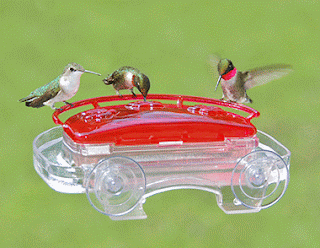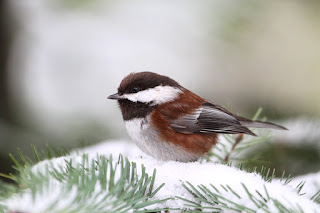HOW DOES IT WORK?
Both styles of heaters contain a low wattage lightbulb inside a cup shape that directs the heat upwards towards your feeder. They are designed to keep your nectar solution above freezing but not hot.
Hummer Hearth heaters are a plastic cup with a 7 watt lightbulb inside. The heater attaches to your feeder using three adjustable elastics with plastic hooks. They are designed to fit tightly against the base of your feeder for the least amount of heat loss possible. A spare 15 watt bulb is included for those nights that reach under -7°C, or if you notice freezing near where the heater contacts. The heater is outdoor rated though we recommend keeping the plug and socket protected if possible. The heater has a 6 foot cord that can be plugged into an outlet or extension cord.
Warm Wings feeder heaters are an aluminum cup with a red powder coating, available in three sizes. These heaters attach to your feeder with the four included elastics and/or plastic s hooks. The heaters are installed with an 11 watt lightbulb and come with an additional 15 watt for the really cold nights. The 6 foot cord includes a dimmer switch to control the current to the heater, which also works as an on/off switch so you don't have to unplug it. It is recommended to keep the dimmer switch protected from the weather to avoid potential issues with rain getting inside. Wrapping it up in something waterproof or keeping it under cover and out of direct rain is ideal.
WHEN DO I USE THE LARGER BULB?
The included higher wattage bulbs should only be used if you are noticing freezing around the base of the feeder, where the heater is attached. This usually doesn't occur unless the outside temperature is around -7 to -10°C. If the feeder is freezing from the top down (for bottle styles), insulate the bottle with a wool sock, bubble wrap, or other insulating material.
WHICH HEATER SHOULD I USE?
All four of them can work with most heater styles. Flat bottomed feeders and saucer style feeders tend to work best with the Hummer Hearth heater because the nectar solution is right above the feeder and it seals tight against the flat base to help keep the heat in. Wider bottomed feeders can benefit from the largest Warm Wings feeder (the Rufous) due to the wider top of the heater allowing the heat to directly reach more of the surface area. The smaller two Warm Wings (the Ruby and Anna) are the most adaptable and can work with any feeder style. They are the ones we prefer for the Perky Pet 8oz. feeders and the like. Mostly, it's down to personal preference!
DO THEY COME WITH A FEEDER?
No, all of our heaters are an attachment for existing feeders and do not come with a feeder included. They are adaptable for use with most styles of feeders, and if you are having trouble or are unsure, bring yours in and we can help you find the right heater.
WHERE ARE THEY MADE?
The Hummer Hearth feeder heater is manufactured in the United States and shipped up to us, and Warm Wings heaters are based out of Nanoose Bay, BC.
CAN I GET REPLACEMENT PARTS?
We do make an effort to keep replacement cords and elastic in stock. We also sell spare bulbs for both heater styles if necessary.
HOW MUCH ARE THEY?
Hummer Hearth: $54.99
Warm Wings Ruby: $49.99
Warm Wings Anna: $59.99
Warm Wings Rufous: $64.99
CAN I ORDER THEM ONLINE?
All of our hummingbird feeder heaters are available in our webstore (https://thebackyard.ca/store/) under Hummingbird Feeders -> Accessories
HOW OFTEN DO I CHANGE THE NECTAR SOLUTION?
Usually in cold weather hummingbird feeders need to be cleaned and refilling with fresh solution once a week. While using your hummingbird heater we recommend changing it two or three times a week to prevent bacterial growth. The heat from the lightbulb acts like the summer sun on your feeder and causes the nectar solution to ferment more quickly than it usually would this time of the year.
Got a question we haven't covered? Let us know!







.jpg)


.JPG)
.jpg)

.jpg)





